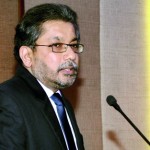Wisdom of ‘Wonder of Asia’ tourism slogan questioned by renowned Lankan economist
View(s):The availability of good, accurate data is one of the key challenges facing the tourism sector in Sri Lanka, according to Saman Kelegama, Executive Director of the Institute of Policy Studies (IPS) of Sri Lanka, highlighting shortcomings in the data collection process.

IPS Executive Director Dr. Saman Kelegama speaking at the AGM.
Delivering the keynote address at the AGM of the Institute of Hospitality – Sri Lanka Chapter, in Colombo on Tuesday, Dr. Kelegama said that for a comprehensive analysis of the sector there needs to be a solid data base. However, available data has a number of shortcomings.
He said firstly the tourism arrival figure for 2013 of 1.27 million is after a correction was made by reconciling on-line and manual figures. “Irrespective of the accuracy of this figure, what anyone studying the tourist sector would like to know is the actual number of tourists who spend 24 hours or more and spend on a hotel night out of this number? The current figure includes many Sri Lankans with foreign passports, foreigners working in embassies for a short period, NGO workers, donor organisation staff – all of whom come for a limited period less than one year, as well as businessmen/traders who come for a couple of nights that are spent with business partners. If all these are factored in, the actual tourist hotel nights will apply only to about 75 per cent of this figure of arrivals,” he said.
The second issue, he said, was that foreign guest nights (FGNs) data from the informal sector is not available. With the popularising of the Internet and social media, many young tourists look for cheaper hotels in the informal sector and all indications are that the informal sector will grow as rapidly as the formal sector. Data indicates that there are close to 11,700 rooms in the informal sector compared to 15,000 rooms in the formal sector and that is the only data available on the informal sector. “Thus, more aggregate data on the informal sector will be useful for policy formulation and making more meaningful decisions on undertaking investment in the tourism sector,” he argued.
Accurate information on FGNs is not available for the registered hotels also as some of these hotels do not submit this information on a timely basis, he said.
Dealing at length with the sector, he said earnings have increased with tourism now occupying the third largest foreign exchange earner to the country (US$1.7 billion-2013) after overseas remittances ($6.4 billion) and textiles and apparel exports ($4.5 billion).
Flagging some important issues, the renowned economist then dealt with the targeted 2.5 million arrivals by 2016 saying that a closer study is needed to assess whether there is an under-supply of hotel rooms.
On data collection, he said that when data is weak, market gossip and herd instinct tend to take over and there can be an over-supply of rooms and cut-throat competition to attract tourists, while the government agencies will give quick approvals to hotel projects without giving much consideration to the qualitative aspects.
Dr. Kelegama also discussed the minimum pricing mechanism and its issues, saying stakeholders will have to work out a compromise formula until a market regulator is established for the sector which is the case in all matured market economies in the world.
“Once a regulator is in place, it will be more prudent to allow the demand and supply forces or the market to take over to discover the equilibrium price. If not, with the occupancy falling, the desired capacity fulfillment will not take place in these hotels and it will prove difficult to achieve the set tourist target,” he said.
Dr. Kelegama also questioned the wisdom of the slogan “Wonder of Asia” asking: What are the wonders that Sri Lanka possess?
“Two items that are noteworthy are Sigiriya and the gathering of elephants in Minneriya. Other than these two, one cannot think of any other wonder in Sri Lanka. Therefore, it is questionable whether the branding of the destination is correctly placed,” he said pointing out to the example of Singapore which at one time was marketed as ‘Uniquely Singapore’.
When that country discovered diminishing returns from that slogan it was changed to “Yours Singapore” to underpin its strengths as a destination.
He said that re-branding these was accompanied by a change in the offerings to tourists with the introduction of Formula One Racing, Casinos, and other night entertainments. The re-branding focused on the experience of a tourist that could be personalised – sound, tastes, sights, user–centricity, etc.
On marketing, he said Sri Lanka lacks a cohesive marketing strategy and campaign which should be a mutually agreed private-public partnership. There are various promotional exhibitions that have taken place in foreign capitals in the past but they are not based on a master plan to promote the market destination. There is much more work that needs to be done in this area.
He said all these challenges need to be addressed on a fast track basis if Sri Lanka is to make the tourism sector an above 5 per cent of GDP contributor to the economy after 2016. This is certainly not an impossible task if a master plan is worked out by the industry and the government, Dr. Kelegama noted.


